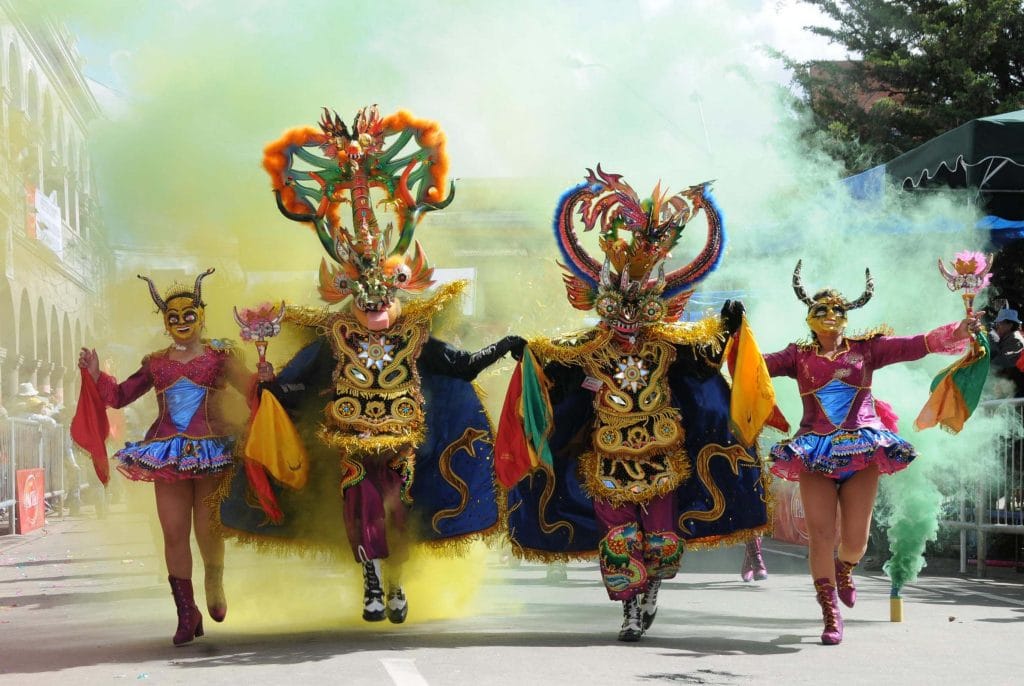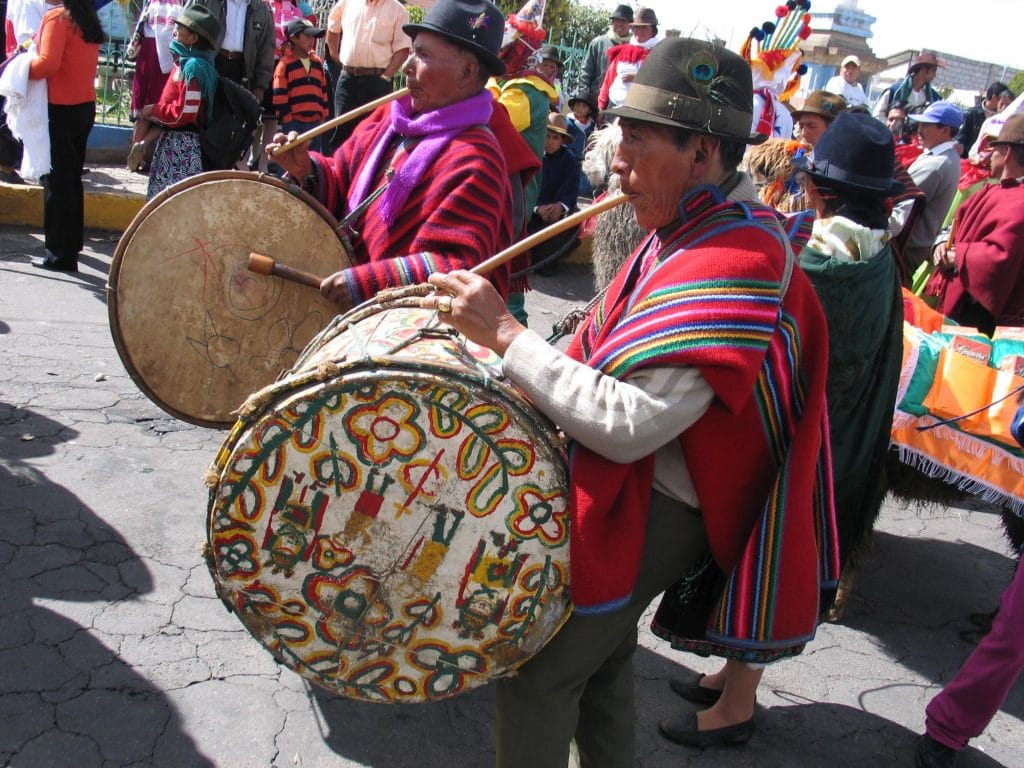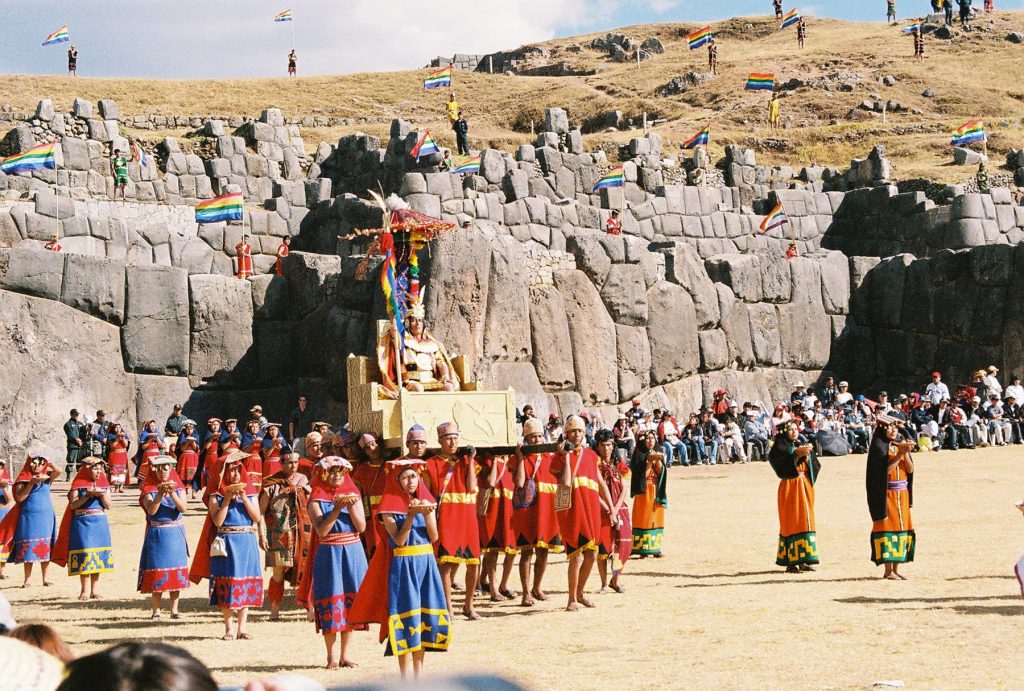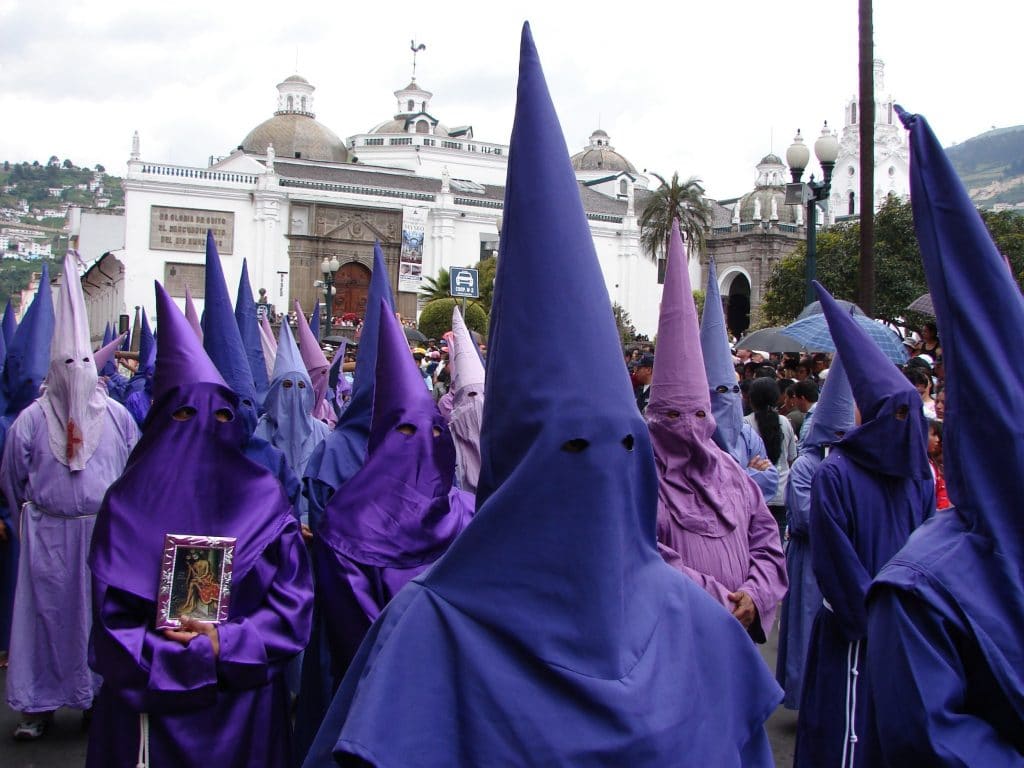Of all the people, on all the continents, South Americans really know how to party. Their indigenous roots and Christian colonization leads to an amazing assortment of fiestas. Chose from indigenous harvest festivals to religious holidays to music performances, with celebrations that range from unbridled chaos to more serene and structured. If you want to visit South America, these South American festivals are worth planning a trip around.

Oruro Festival, Bolivia. Photo courtesy of VMT Bolivia.
1) Celebrate The Virgin Of The Mineshaft At The Oruro Festival In Oruro, Bolivia
Travel back in time in one of the highest and most remote countries on earth. Bolivia is rich in both silver and local culture, with more indigenous peoples than any other country in the Americas. You can experience this diverse mix of multi-ethnic cultural experiences first-hand combined with the importance of salt mines if you visit during the Oruro Festival in one of Bolivia’s old mining towns.
Legend has it that in 1756, a mural of the Virgin Mary miraculously appeared in a mineshaft of the city’s richest silver mine. Ever since, the townspeople have honored the Virgen del Socavon (Virgin of the Mineshaft) at their annual Carnival at and around the Sanctuaria del Socavon (Church of the Mineshaft). The carnival starts with a ceremony dedicated to the Virgen del Socavon before about 50 groups of folk dancers perform a pilgrimage to the Tunnel Shrine. Marching bands greet the Virgin with a competition in the grotto of Pie de Gallo and the festival culminates in a three-day parade.
While in Bolivia, further explore the mining culture with a visit to San Jose silver mine. For a truly out-of-this-world experience, visit the Salt Desert of Uyuni with 4,000-square-miles of salt flats. You’ll see locally fashioned structures made entirely out of salt bricks including a historic hotel and Isla de Pescadores, a bizarre island studded with 20-foot cacti. You can also unwind at the luxury hotels on shores of Lake Titicaca, South America’s largest lake.

Candelaria Festival in Puno, Peru. Photo courtesy of Adventure Life.
2) Do The Devil Dance At The Candelaria Festival In Puno, Peru
If you want to hop on over to the other side of Lake Titicaca, consider visiting the Peruvian side. This lake is covered with islands made and remade with totora reeds, which provide home, sustenance and transportation to more than 530 aquatic species. Try to time your visit to coincide with the first fortnight of February each year for Fiesta de la Candelaria in the nearby city of Puno.
Like many South American festivals, it owes its origins to ancient agricultural rituals linked to the harvests. Dancers decked out in sequined costumes and grotesque masks play pipes and make offerings to Pachamama, or “Mother Earth.” You will witness pre and post Colombian dances, as well as the principal Candlemas dance the diablada, or devil dance where people in terrifying devil masks face off with people in sparkling “suits of lights.” In addition to street dancing every day, make sure you attend the 12-hour Folkloric Parade throughout Puno. This is one of the largest festivals of culture, music and dancing in Peru and one of the top three in South America.

Corpus Christi Harvest Celebration in Celebrate The Harvest in Pujilí, Ecuador. Photo courtesy of Adventure Life.
3) Celebrate The Harvest With Corpus Christi Festival In Pujilí, Ecuador
Ecuador has a long tradition of indigenous festivals that have been incorporated into the Christian tradition, blending Catholic and native influences. Ecuadorians love a party and put on a show, providing a nearly endless supply of food and drink. What better place to experience one of these festivals than Pujilí, a small town that typically doesn’t see many tourists?
Each June, thousands of Ecuadorians congregate here for the Corpus Christi festival that combines the celebration of Holy Communion and the celebration of the harvest to Inti, the Incan Sun God. This multi-day fiesta showcases regional and folkloric dance, music, cuisine and art and culminates in the El Danzante parade. While in town, check out Pujilí’s local market, featuring pottery, ceramics and clothes that people travel miles to buy.
If you wanted to penetrate another area of Ecuador largely unexplored and unmapped by tourists, visit the Latacunga National Park just ten to twenty minutes away. This park encompasses the stunning lakes and rivers of Andean forests along with Amazonian forest habitats. The park houses over 800 plant, 194 bird and 51 mammal species.

Procession during the Inti Raymi festival in Cusco, Peru. Photo courtesy of Adventure Life.
4) Await The Return Of The Sun God At The Inti Raymi Festival In Cuzco, Peru
To attend another celebration of Inti, the Incan Sun God, travel to Cuzco, Peru. The ancient Incans gathered in Cuzco to plea for the Sun God’s return during the winter solstice, when the sun is farthest from the earth. Historically, celebrants fasted for days before the event then enjoyed a lavish banquet of meat, corn bread and chicha (corn beer) as they prepared to sacrifice a white llama to ensure fertile fields. When you visit, you’ll witness colorful dances, processions and skits, culminating in the parade where they feign sacrificing a white llama.
There’s no better place to honor the Sun God than Cuzco, whose imperial city enchants visitors with dazzling temples and access to famed Inca ruins. For beautiful views of the city, visit the Sacsayhuamán ruins. While you’re here, make sure you plan a route to Peru’s best ruins at Machu Picchu.

Argentinian Tango Festival in Buenos Aires. Photo courtesy of Adventure Life.
5) Dance Your Heart Out At The Tango Festival In Buenos Aires, Argentina
Celebrate ‘the world’s biggest tango extravaganza’ in the city that gave birth to this dramatic dance. The event begins with La Festival featuring tango shows and recitals, dance lessons and film screenings at venues across the city – before morphing into the Tango World Championship, where dancers compete for glory. Make sure you watch dancers at the massive open-air milonga, where over ten thousand tangueros float across the cobbled streets of central Buenos Aires.
Once you’ve had enough of Argentinean tango, check out gaucho culture with a trip to San Antonio de Areco, 70 miles (113 kilometers) north of the city. Get a taste of rural living at one of Pampas’s many surrounding estancias, or ranches. Arrange to visit for a day to ride horses, eat asado (barbeque) and watch gauchos’ impressive displays of horsemanship. It’s also a great place to get authentic souvenirs at local silversmith shops selling belt buckles and spurs.

Easter Festival in Quito Ecuador. Photo courtesy of Adventure Life.
6) Usher In Easter With Semana Santa In Quito, Ecuador
All across Ecuador, locals prepare for Easter with festive processions through the streets, religious statues carried shoulder high, and thousands of cross-bearing devotees. Residents usher in Semana Santa on Palm Sunday by waving traditional ramas (palm fronds) with the celebrations continuing until Easter Sunday.
Although you can find this throughout the country, some of the most scenic celebrations are found near the Spanish Colonial churches and squares of the capital’s historic center. Make sure you visit “La Iglesia de la Compañía de Jesús,” built in the early 1600s in the Baroque style with a central nave glittering with gold lead. Also explore the massive two-block Iglesia y Monesterio de San Francisco complex in the Old Town district. Before the week is over, make sure you try fanesca, the delicious stew typically eaten during this time of year.
What’s your dream South American festival? Have you been to any of the above? Please share in the comments below.

Jessica Festa is the editor of the travel sites Jessie on a Journey (http://jessieonajourney.com) and Epicure & Culture (http://epicureandculture.com). Along with blogging at We Blog The World, her byline has appeared in publications like Huffington Post, Gadling, Fodor’s, Travel + Escape, Matador, Viator, The Culture-Ist and many others. After getting her BA/MA in Communication from the State University of New York at Albany, she realized she wasn’t really to stop backpacking and made travel her full time job. Some of her most memorable experiences include studying abroad in Sydney, teaching English in Thailand, doing orphanage work in Ghana, hiking her way through South America and traveling solo through Europe. She has a passion for backpacking, adventure, hiking, wine and getting off the beaten path.








